Conducted at Long Island Horticultural Research & Extension Center, Cornell University
Primary Focus was on Managing Phytophthora Blight
Printer-friendly .pdf version of this page.
See also:
- Reduced-tillage for Managing Phytophthora Blight and Other Soil-Borne Pathogens. This extension webpage has tips on using reduced-tillage, a video and several more photographs.
- Phytophthora Blight and Its Management in Cucurbit Crops and Other Vegetables
Below is a summary of the experiments conducted by year followed by reports. Click on the year to jump to the report.
2004. Pumpkin. First Year
In 2003 the field was in cover crop (Sorghum Sudan grass) during growing season. No-till seeded rye on 2 Nov 2003.
Dutch white clover was no-till seeded to reduced-till plots and driveways on 11 May when rye was just starting to head out.
Rye was rolled twice with a cultipacker in reduced-till plots on 2 June when rye was pollinating. In mid-June, rye that remained standing was flail chopped.
Reduced tillage plots were worked on 7 June using Unverferth zone builder and a zone-till cart (equipment comparison expt).
In mid-June conventional-tillage plots were rototilled.
On 23 June pumpkin was seeded.
Penetrometer measurements were made on 23-24 Sep (see report below).
In Oct, the field was mowed to remove weeds and break-up remaining pumpkin fruit, conventional-till plots were disked twice, then the whole field was seeded to rye at 5.3 bu/A using a non-till seeder on 13 Oct.
2005. Pumpkin.
Dutch white clover was no-till seeded to reduced-till plots and driveways on 15 April when rye was 5-8 inch tall.
On 31 May, rye was flail chopped in conventional-till plots and driveways and in reduced-till plots rye was rolled twice with a cultipacker.
On 20 Jun zone builder was used to cut rows in the reduced tillage plots. The rows were re-worked twice more to apply liquid fertilizer which couldn’t be done with the seeded as planned.
The conventional-till strips were mowed on 20 June. A finger-weeder was used to pull straw out of these strips. These strips were subsoiled and rototilled on 23 June.
Soil was very dry and broke apart easily to a pulverized appearance in both reduced-till and conventional-till plots.
Pumpkins were seeded on 6 July.
Penetrometer measurements were made (see report below).
In Oct, the field was mowed to remove weeds and break-up remaining pumpkin fruit, conventional-till plots were disked twice, then the whole field was seeded to rye at 4.5 bu/A using a non-till seeder on 31 Oct.
2006. Pumpkin.
Dutch white clover (10 lb/A) was no-till seeded to the first 250 feet of the reduced-tillage plots and the entire length of the driveways on 12 April and subterranean clover (190 lb/A) was planted to the last 50 feet of each reduced-till plot on 13 April.
On 22 May, rye was rolled twice with a cultipacker in the reduced-tillage plots and was flail chopped in conventional-till plots and driveways.
On 21 June an Unverferth zone builder was used to cut and fertilize rows in the reduced tillage plots.
The conventional-till strips were rototilled on 21 June.
Pumpkins were seeded on 3 July.
In Oct, the field was mowed to remove weeds and break-up remaining pumpkin fruit, conventional-till plots were disked twice, then the whole field was seeded to rye using a non-till seeder.
2007. Pumpkin and Sweet Corn.
Production practices similar to previous years except corn seeded at 34-in row spacing. No clover seeded.
2008. Pumpkin and Sweet Corn.
On 1 May the conventional-till plots were subsoiled. Rye was flail chopped on 26 May. Some of the rye straw was removed from the conventional-till plots by using a Robe Werk cultivator to drag straw to the field end. The plots were roto-tilled on 11 June to incorporate the remaining rye straw and prepare for seeding.
Rye was rolled in the reduced-till plots on 26 May twice and again on 10 June.
On 26 June the zone builder was used to prepare and fertilize rows in the reduced-till plots. Soil was in larger clumps after 1 pass with the zone builder than in past years, perhaps due to the soil being moister than ideal for this process, but with field preparation already delayed by rain and rain forecast it was decided this was the best time to prepare the beds. The zone builder was run twice through the field to create a smoother seed bed.
Pumpkins were seeded on 2 July.
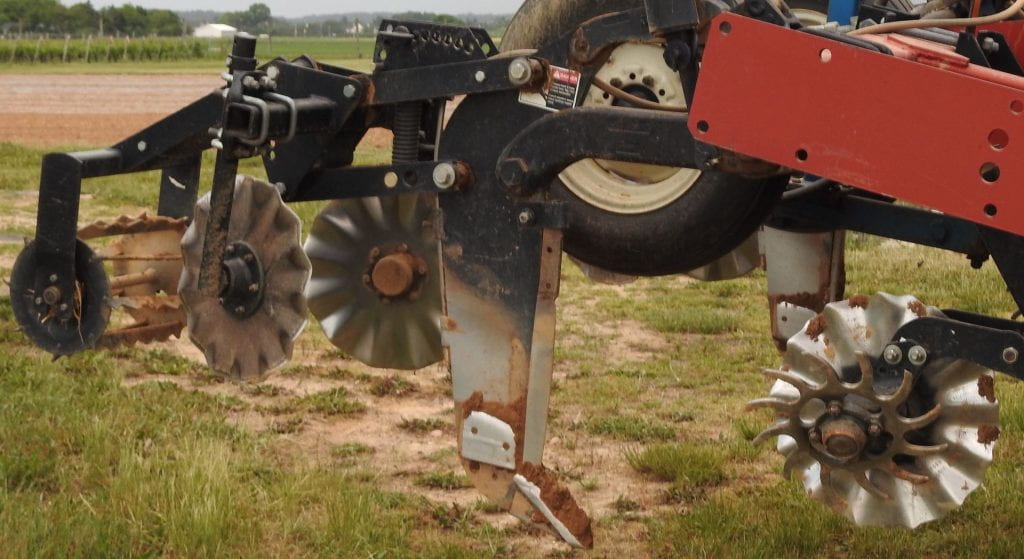
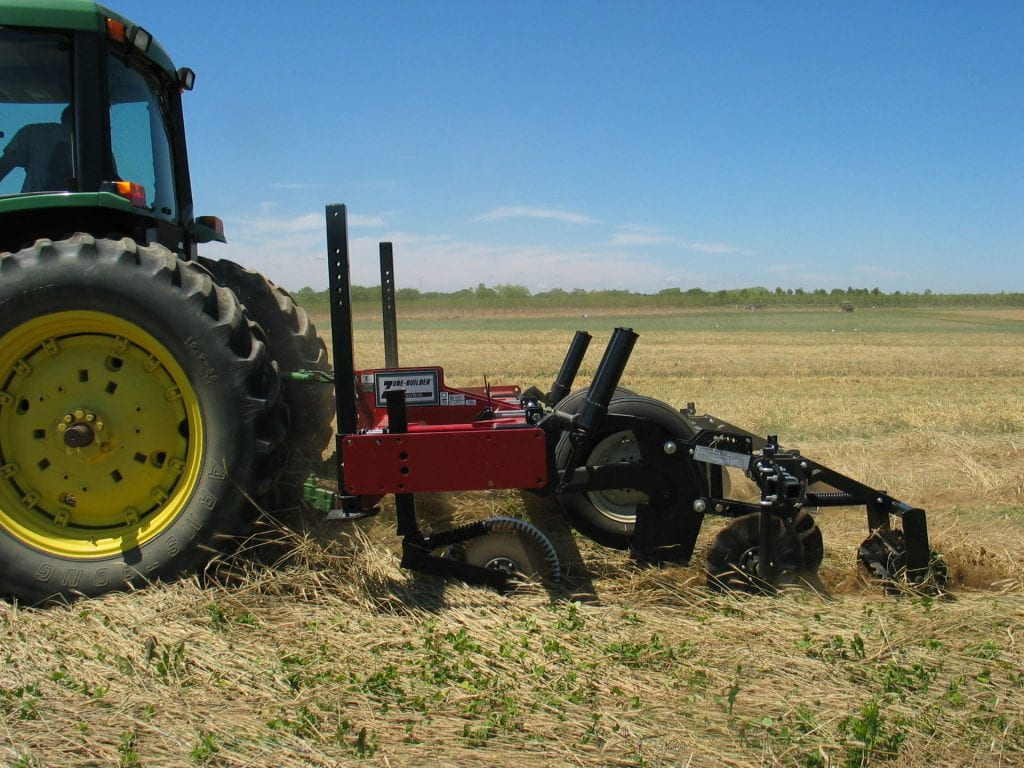
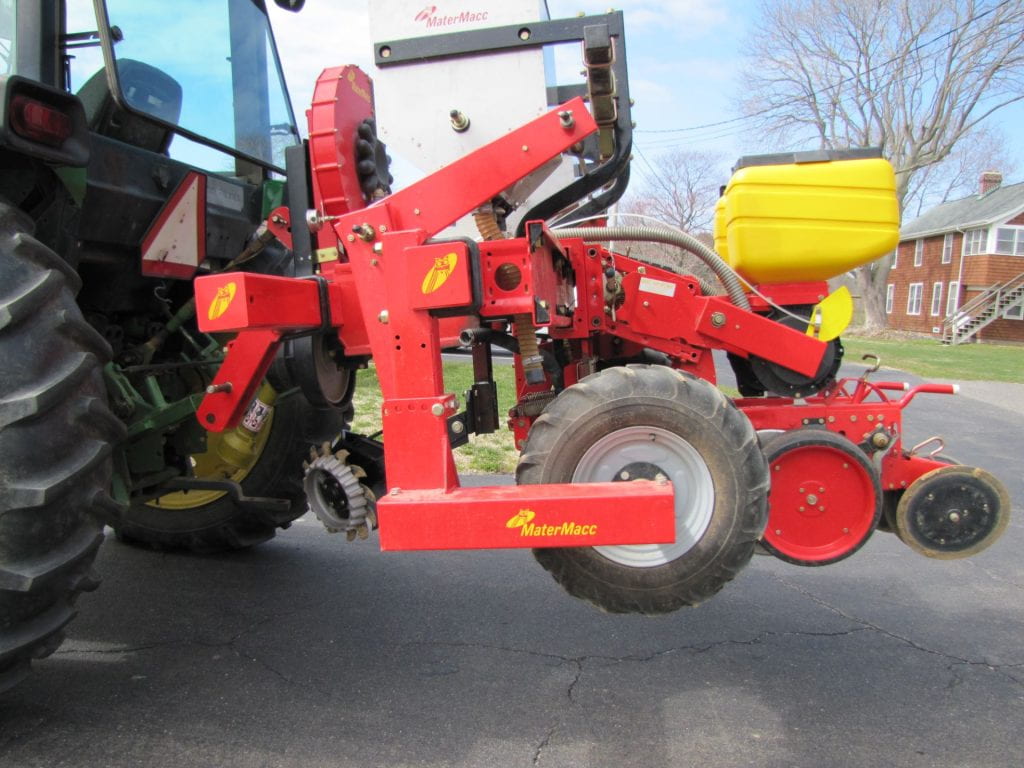
Evaluation of Reduced Tillage Production System with Conventional and Controlled Release Fertilizer for Pumpkin, 2008
Investigators: M. McGrath, S. Menasha and G. Fox
Fine-tuning the weed management program and testing a fertilizer program with controlled release fertilizer were the goals of research on reduced-till pumpkin production in 2008. Inadequate weed control has been the main challenge to successful reduced-till pumpkin production in previous experiments conducted at LIHREC (Long Island Horticultural Research & Extension Center). A modified herbicide program was used in 2008. Half of the reduced-till and half the conventional-till plots received controlled release fertilizer while the other plots received conventional, soluble fertilizer as in past experiments. This objective was identified as a priority to examine because of the escalating interest in this type of fertilizer to reduce the potential for contaminating ground-water with leached conventional fertilizer, an especially important issue on Long Island, and to provide fertilizer as needed during the growing season without side-dressing.
The experiment was conducted in a research block that has been dedicated to reduced tillage research since 2004. This 1.7A field has 4 pairs of conventional and reduced tillage plots that run the 300-ft length of the field. In Oct 2007, the field was mowed to remove weeds and break-up remaining pumpkin fruit and corn stalks from that year’s crops, conventional-till plots were disked twice, then the whole field was seeded to rye at 4.5 bu/A using a non-till seeder.
Conventional-till strip-plot preparation. On 1 May 2008 the conventional-till plots were subsoiled. Rye was flail chopped on 26 May, which is when rye was rolled in the adjacent reduced-till plots, and again on 10 June. Some of the rye straw was removed from the conventional-till plots by using a Robe Werk cultivator to drag straw to the field end. The plots were roto-tilled on 11 June to incorporate the remaining rye straw and to prepare the soil for seeding. Plots in replications 1 and 3 received conventional fertilizer: before seeding 10-10-10 fertilizer at 250 lb/A (25 lb/A N) was broadcast and incorporated by disking, then 500 lb/A 10-10-10 fertilizer was applied with the seeder. Plots in replications 2 and 4 received controlled release fertilizer: 750 lb/A 10-10-12 controlled release fertilizer was applied with the seeder.
Reduced-till strip-plot preparation. On 26 May, rye was rolled twice with a cultipacker in the reduced-till. Round-up WeatherMax (22 oz/A) was applied on 3 June. On 26 June a 2-row Unverferth zone builder was used to prepare and fertilize rows in the reduced-till plots. For each row this piece of equipment has a 20-inch coulter to open the row, shank to disrupt plow pans and create compression fissures between the shanks and 2 17-inch wavy coulters followed by a 15-inch wide rolling basket to prepare the soil for planting. Rows were at 68-in spacing. Soil was in larger clumps after 1 pass with the zone builder than in past years, perhaps due to the soil being moister than ideal for this process, but with field preparation already delayed by rain and rain forecast it was decided this was the best time to prepare the beds. The zone builder was run twice through the field to create a smoother seed bed. Liquid fertilizer was applied during the second pass to the conventional fertilizer plots. The Unverferth is set-up to inject liquid fertilizer at about 4-inch depth through a nozzle placed on the back of each shank. was used to inject 25.5 gpa of liquid 9-18-9 fertilizer (= 25 lb/A N). 500 lb/A 10-10-10 fertilizer was applied with the seeder. The controlled release fertilizer plots received 750 lb/A 10-10-12 applied with the seeder.
‘Gargoyle’ pumpkin variety was used for all plots. It was too windy to apply herbicide immediately after seeding on 2 July. On 3 July Strategy (3 pt/A), Sandea (0.5 oz/A), plus RoundUp WeatherMAX (32 oz/A) were applied across the entire plot. In the past Sandea was not applied before pumpkins had emerged and Strategy was applied at a lower rate (2 pt/ treated A) in a 36-inch band over the planted row. It was not possible to irrigate the field immediately after treatment to activate the Strategy, but rain fell the next day (0.22 in.). The entire field was overhead irrigated when dry throughout the season. Pumpkins were harvested on 15 Oct from two rows in a 40-ft section of each plot. Marketable fruit were counted and weighed. Green and rotten fruit were counted.
Weed control was better in 2008, especially in the reduced tillage plots, than in previous years. Effectively controlling weeds in reduced-till pumpkins with Strategy is challenging because, as stated on the label, plant residue, existing weeds and cloddy soil conditions interfere with performance of this herbicide. Poor control in past years with Strategy was also likely due to there being no water, as irrigation or rain, shortly after the application was made. Any weeds that germinate before water activated Strategy would not be affected by this herbicide. In addition to using the highest label rate of Strategy in 2008, the spectrum of weed control achievable with Strategy was augmented by also applying Sandea and RoundUp.
Grubs were found feeding on the ground-side of a high percentage of fruit in both the conventional and reduced-till plots. There were both oriental beetle grubs and Asiatic garden beetle grubs. Adult beetles may have been attracted to the field because of the quantity of organic matter plus the permanent driveways between each replication. A few slugs were also seen.
There was a higher percentage of rotten fruit in the conventional-till plots than in the reduced-till plots (35% versus 13%). Phytophthora fruit rot was the primary cause.
Average weight of fruit was slightly, but significantly, greater for conventionally-produced pumpkins: 3.6 lb versus 3.4 lb.
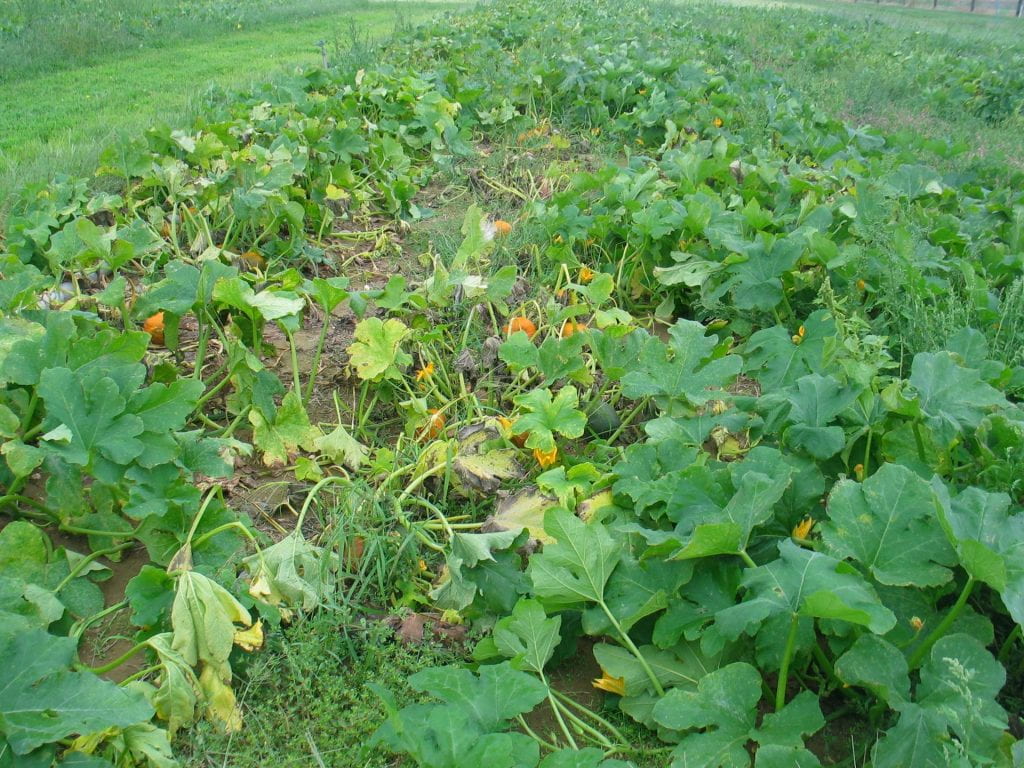
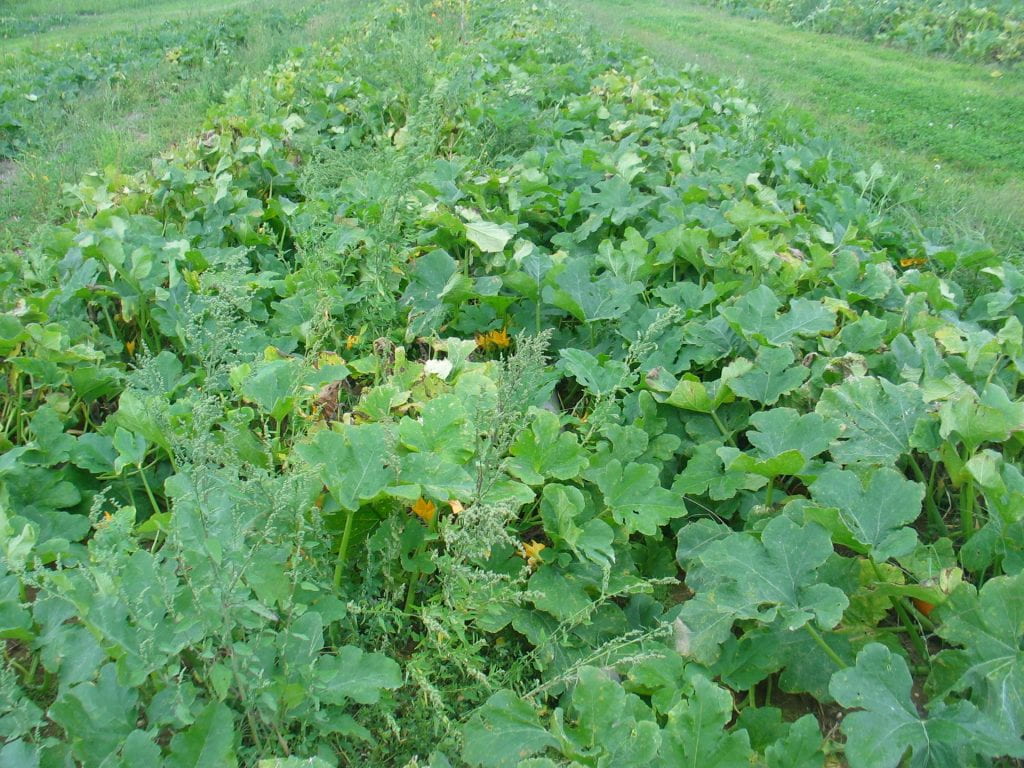
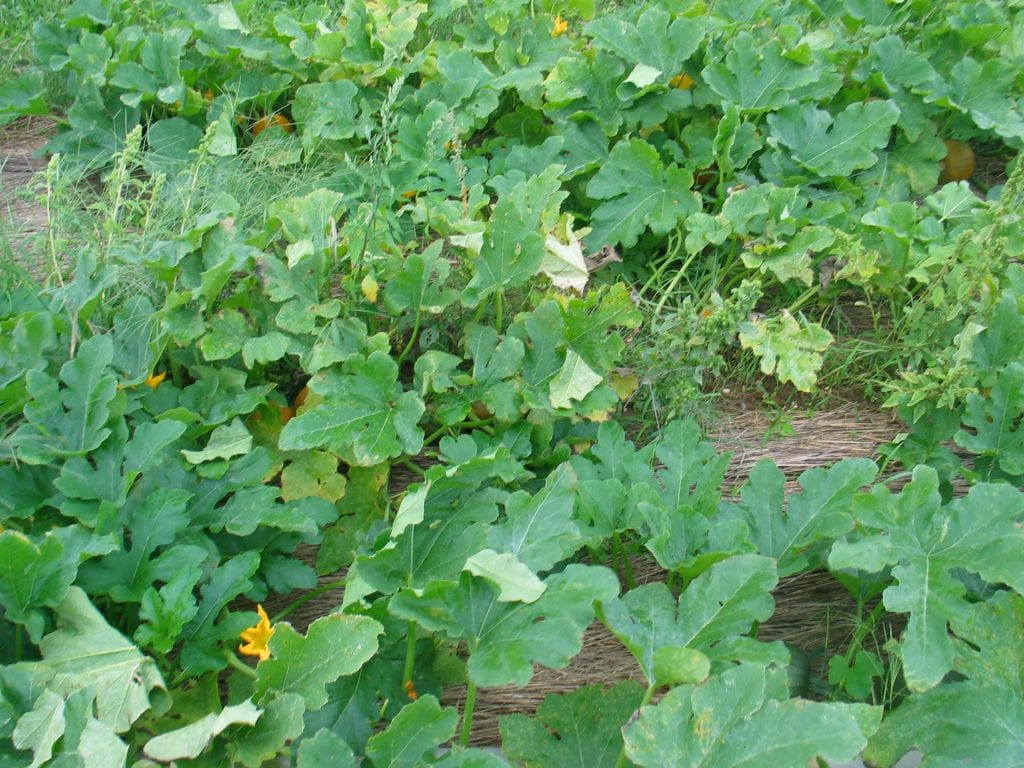
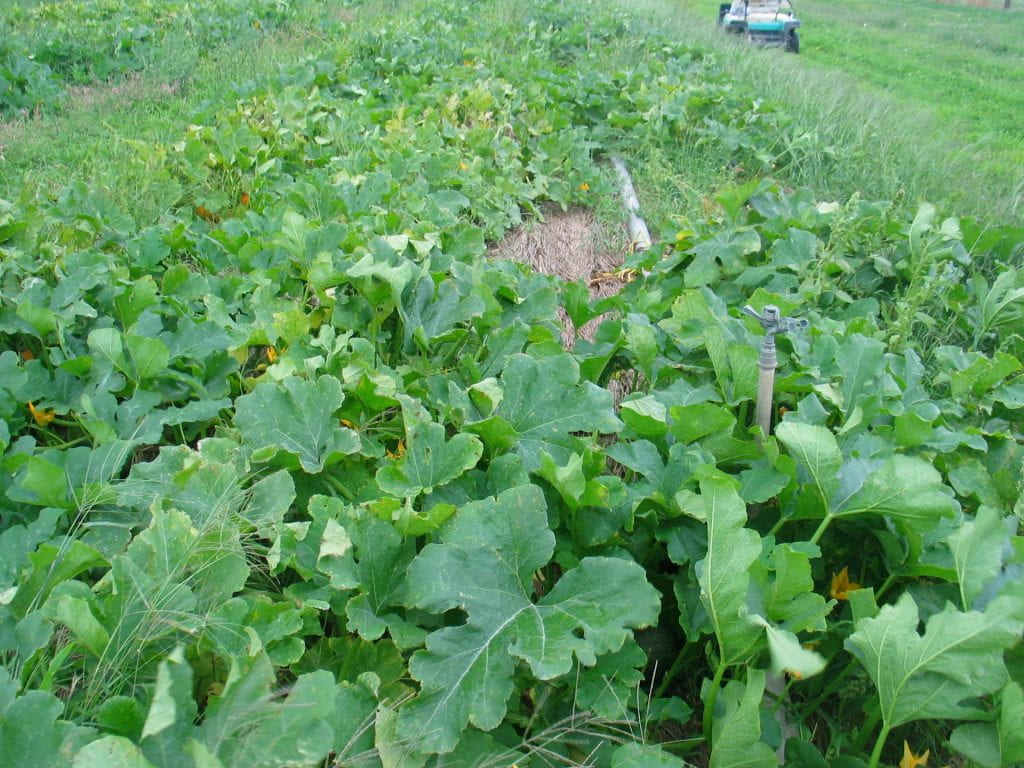
Reduced-Till Sweet Corn Production at Two Nitrogen Rates, 2007
Investigator: S. Menasha
Cooperators: A. Rangarajan and Agricultural Stewardship Program
In November 2006, rye was no-till seeded at 4.5 bushels per acre (A). On May 24, 2007 rye was rolled twice with a cultipacker in the reduced-till (RT) strips and was flail chopped in the conventional-till (C) strips. After the rye was rolled, Roundup WeatherMAX was applied at a rate of 22 oz/A to the reduced-till strips in order to kill any emerged weeds and any rye that was not killed previously by the rolling process. On June 18, an Unverferth zone builder was used to cut, fertilize, and prepare four reduced-till strips, 100 ft in length, in each plot for planting. Liquid fertilizer (9-18-9) was injected with the Unverferth at a rate of 25 lbs of nitrogen (N) per acre (A) into the reduced-till strips to a depth of about 4”. On the same date, conventional-till strips were also prepared for planting. Rye was incorporated with a rototiller and 25 lbs N/A of a 13-13-13 fertilizer was broadcast onto all conventional-till plots. ‘Providence’ sweet corn was seeded on June 20 with a vacuum seed planter. At the time of planting, 50 lbs N/A (13-13-13) was banded 2” to the side and 2” below the seed. A sidedress application of nitrogen was applied to all treatments on July 12 and watered in. For each tillage treatments, 2 of the 4 replicate plots received 25 lbs N/A from urea (34-0-0) while the remaining 2 replicate plots in each tillage treatment received 75 lbs N/A also from urea (34-0-0). Different N rates were applied in order to evaluate the effects nitrogen rates had on sweet corn yield and quality under the different tillage practices. Weeds were controlled primarily with herbicides. Insects were managed according to Cornell Guidelines. Corn was harvested from two, 20 ft sections from the center 2 rows of each plot. Measures on yield and ear quality were recorded and analyzed.
Marketable yields were significantly greater in the reduced tillage treatments compared to the conventional tillage treatments. Furthermore, within each tillage practice, nitrogen rates did not have a significant effect on the number of dozen ears/A. So, although marketable yield in the conventional-till plots were numerically greater at 150 lbs N/A compared to 100 lbs N/A, the differences in yield were not significant. Additionally, ear quality characteristics such as ear length, ear diameter, and tip fill were not significantly influenced by either tillage practice or nitrogen rate.
Reduced-Till Pumpkin Production in Rye Straw Mulch Plus Clover Living Mulch, 2006
Investigators: M. T. McGrath, A. Senesac, and J. F. Davey
A long-term study was started in 2004 to address the impact of reduced tillage on soil health and diseases of vegetable crops. The 1.7-A field for this study is divided into 4 replicate sets of reduced tillage and conventional tillage strip plots extending the length of the field (20 ft X 300 ft) separated by driveways. The production system being examined is pumpkin zone-till seeded into rye straw mulch with a Dutch white clover living mulch planted between the pumpkin rows. This idea arose from discussions with an organic farmer who successfully grows pumpkins on plastic mulch with clover planted between the plastic. The system is being tested for continuous pumpkin production by switching location of clover and pumpkin strips each year. Using a clover living mulch between rows of a crop provides an opportunity to put some land into a cover crop where rotation out of crops is not feasible due to the value of the land, as is the case for many Long Island fields. A living mulch also can suppress weeds. Soils with good health have higher organic matter content and higher microbial activity than poor quality soils, consequently there is greater potential for biological control of soil-borne pathogens. Straw and clover mulches provide a ground cover that can be a barrier for the pathogen. Thus this production system may be an effective management practice for pumpkin fruit rots, which are mostly caused by soil-borne pathogens and tend to be worst where rotation is minimal as is common for u-pick fields.
In Oct 2005, the field was mowed to remove weeds and break-up remaining fruit from that year’s pumpkin crop, conventional-till plots were disked twice, then the whole field was seeded to rye at 4.5 bu/A using a non-till seeder on 31 Oct. Fertilizer (40 lb/A of N as 34-0-0) was broadcast on 10 April 2006. Dutch white clover (10 lb/A) was no-till seeded to the first 250 feet of the reduced-tillage plots and the entire length of the driveways on 12 April and subterranean clover (190 lb/A) was planted to the last 50 feet of each reduced-till plot on 13 April. On 22 May, rye was rolled twice with a cultipacker in the reduced-tillage plots and was flail chopped in conventional-till plots and driveways. Round-up WeatherMax (22 oz/A) was applied on 5 Jun in a 36-inch band over the rows where pumpkins were to be planted in the reduced-till plots. On 21 Jun an Unverferth zone builder was used to cut and fertilize rows in the reduced tillage plots. It was set up to prepare 2 rows at 68-in spacing. For each row this piece of equipment has a 20-inch coulter to open the row, shank to disrupt plow pans and create compression fissures between the shanks and 2 17-inch wavy coulters followed by a 15-inch wide rolling basket to prepare the soil for planting. Since plots were set-up for 3 rows of pumpkins, the center row was cut twice. Liquid fertilizer (9-18-9) at 25 lb/A of N was injected into the reduced-till plots with a nozzle placed on the back of the shank such that it was at about 4 inch depth. Unfortunately there was a leak in the pump gauge resulting in some fertilizer being lost on the soil surface and possibly a reduced amount being injected into the soil. The conventional-till strips were rototilled on 21 Jun. Seed was planted with a vaccum seed planter on 3 Jul with 300 lb N/A (N-P-K 10-10-10) fertilizer. Weeds were managed primarily with herbicides. Conventional-till plots were also cultivated. Round-up and was applied on 5 Jun in a 36-inch band in the reduced-till plots to control weeds and clover in the pumpkin rows as well as mark their location; there were few weeds then. Strategy (2 pt/treated A) and Round-up WeatherMax (22 fl oz/treated A) was applied over all pumpkin rows in a 36-inch band on 5 Jul and rain began about 2 hours later. Poast (1.5 pt/treated A) was applied to all pumpkin rows on 31 July to control emerged grasses. The entire field was overhead irrigated as needed.
The subterranean clover did not grow as well as the Dutch white clover, thus it does not appear to be a better choice. The number and weight of fruit per plant were statistically equivalent, although numerically lower for the reduced-till than the conventional-till plots, and the average fruit weight was also the same for both treatments. There were significantly fewer rotten fruit per plant in the reduced tillage plots. Weed control was again poor, especially in the reduced tillage plots, due to timing of herbicide applications. Rain occurred when Strategy and Round-up were applied after planting, thus these products were ineffective. Pumpkin plants emerged before the field was dry enough to re-apply. Weeds were numerous and well established when Poast was applied 4 weeks after seeding. Cultivation done in the conventional-till plots resulted in better weed control, but it was still not considered adequate. The competition for nutrients and sunlight between weeds and pumpkin plants visually appeared to be a limiting factor especially in the reduced-till plots, but no significant effects on the overall yielding ability of this treatment were found at the end of the season.
Reduced-Till Pumpkin Production in Rye Straw Mulch Plus Clover Living Mulch, 2005
Investigators: M. T. McGrath, D. D. Moyer, and J. F. Davey
A long-term study was started in 2004 to address the impact of reduced tillage on soil health and diseases of vegetable crops. The 1.7-A field for this study is divided into 4 replicate sets of reduced tillage and conventional tillage strip plots extending the length of the field (20 ft X 300 ft) separated by driveways. The production system being examined is pumpkin zone-till seeded into rye straw mulch with a Dutch white clover living mulch planted between the pumpkin rows. This idea arose from discussions with an organic farmer who successfully grows pumpkins on plastic mulch with clover planted between the plastic. The system is being tested for continuous pumpkin production by switching location of clover and pumpkin strips each year. Using a clover living mulch between rows of a crop provides an opportunity to put some land into a cover crop where rotation out of crops is not feasible due to the value of the land, as is the case for many Long Island fields. A living mulch also can suppress weeds. Soils with good health have higher organic matter content and higher microbial activity than poor quality soils, consequently there is greater potential for biological control of soil-borne pathogens. Straw and clover mulches provide a ground cover that can be a barrier for the pathogen. Thus this production system may be an effective management practice for pumpkin fruit rots, which are mostly caused by soil-borne pathogens and tend to be worst where rotation is minimal as is common for u-pick fields.
In Oct 2004, the field was mowed to remove weeds and break-up remaining fruit from that year’s pumpkin crop, conventional-till plots were disked twice, then the whole field was seeded to rye at 5.3 bu/A using a non-till seeder on 13 Oct.
Fertilizer (50 lb/A of N as 34-0-0) was broadcast on 14 April 2005. Dutch white clover was no-till seeded to reduced-till plots and driveways on 15 April when rye was 5-8 inch tall. On 31 May, rye was flail chopped in conventional-till plots and driveways and in reduced-till plots rye was rolled twice with a cultipacker. Rye was starting to produce seed. Some rye lifted back up in the reduced-till plots after rolling, so rye was re-rolled on 6 Jun. Rolled rye then was green in contrast with the yellow chopped rye. Round-up WeatherMax (22 oz/A) was applied on 14 Jun in a 36-inch band over the rows where pumpkins were to be planted in the reduced-till plots. On 20 Jun an Unverferth zone builder was used to cut rows in the reduced tillage plots. It was set up to prepare 2 rows at 68-in spacing. For each row this piece of equipment has a 20-inch coulter to open the row, shank to disrupt plow pans and create compression fissures between the shanks and 2 17-inch wavy coulters followed by a 15-inch wide rolling basket to prepare the soil for planting. Since plots were set-up for 3 rows of pumpkins, the center row was cut twice. The conventional-till strips were mowed on 20 Jun. A finger-weeder was used to pull straw out of these strips. Conventional-till strips were subsoiled and rototilled on 23 Jun. Soil was very dry and broke apart easily to a pulverized appearance in both reduced-till and conventional-till plots.
On 29 Jun granular fertilizer (10-10-10) at 25 lb/A of N was broadcast and incorporated in conventional-till plots. On 6 Jul liquid fertilizer (9-18-9) at 25 lb/A of N was injected into the reduced-till plots using the Unverferth zone builder at about 2-4 inch depth 3 to 7 inches from center where pumpkin seed were to be placed. It was not possible to mount the liquid fertilizer tank and pump on the pumpkin seeder as planned, and the wheel for the ground-driven pump did not contact the ground until the rows were re-worked, thus these rows were worked 3 times, including 20 Jun, rather than once as intended. Additionally, the center row was done twice each time with fertilizer banding done on both sides of center. The reduced-till rows became sunken likely due to the extra working. Pumpkins were seeded on 6 Jul, 3 rows per plot spaced 68-in apart. On 2 Aug all pumpkin rows were side-dressed with 34-0-0 at 30 lb/A of N. Conventional-till plots were cultivated to incorporate the fertilizer and control weeds.
Weeds were managed primarily with herbicides. Conventional-till plots were also cultivated. Round-up was applied on 14 Jun in a 36-inch band in the reduced-till plots to control weeds and clover in the pumpkin rows as well as mark their location; there were few weeds then. Strategy, plus the fungicide Ridomil Gold, was applied over all pumpkin rows in a 36-inch band on 7 Jul. Rainfall on 8 Jul (0.6 inch) and 9 Jul (0.42 inch) should have been adequate for activating the herbicide. Plants were slow to emerge likely because of poor seed placement (seed were found just below the surface as well as more than 2 inch deep) and also perhaps inadequate water under extremely dry conditions. Emerged pumpkins were not observed until 13 days after seeding. Poast (1.5 pt/A)and Sandea (0.5 oz/A) were applied to control emerged grass and broadleaf weeds on 9 Aug when pumpkin plants had 2-5 leaves and thus could tolerate the Sandea, at least 5 days had passed after cultivation, and rain was forecast. Unfortunately weeds had grown too big to be controllable by Sandea.
One half of the field was overhead irrigated when dry throughout the season and the other half was left non-irrigated. Pumpkins were harvested on 27 Sep from 15-ft sections of each plot. Fruit were harvested from additional sections on 30 Sep to determine the impact of the double band of fertilizer applied to the center reduced-till pumpkin rows. A penetrometer was used on 18 Oct to measure soil compaction at 3-inch increments to 15 inch depth.
The major differences found in this trial were between the irrigated and non-irrigated sections of the field. Average fruit weight was 4.9 lb for both conventional-till and reduced-till pumpkins grown with irrigation, which was significantly greater than fruit weight for the non-irrigated pumpkins (2.7 lb and 2.3 lb, respectively). Pumpkins grown under conventional tillage produced more fruit than those grown under reduced tillage in the irrigated half of the field (3 versus 1.9 fruit/plant) but not the non-irrigated half (2 versus 1.5 fruit/plant). Average fruit weight did not differ significantly between the reduced-till pumpkin rows receiving 25 lb/A of liquid N in a single band before planting and those receiving 50 lb/A of N in a double band. Fruit weight also did not differ significantly for plants in the outer and inner rows of conventional-till pumpkins.
Penetrometer readings were always lowest for measurements made in the row of the reduced-till plots, as expected due to the deep shank on the Unverferth zone builder, but these values were not significantly different from the measurements made in the row of the conventional-till plots. Readings were always significantly greatest for measurements made between the rows of the reduced-till plots, which was not too surprising considering the extra tractor traffic through these plots for establishment. For example, at 9-inch depth readings were 19 psi for in row of reduced-till plots, 61 psi for in row of conventional-till plots, 99 psi for between rows of conventional-till plots, and 289 psi for between rows of reduced-till plots
Project funded by the Friends of Long Island Horticulture Grant Program.
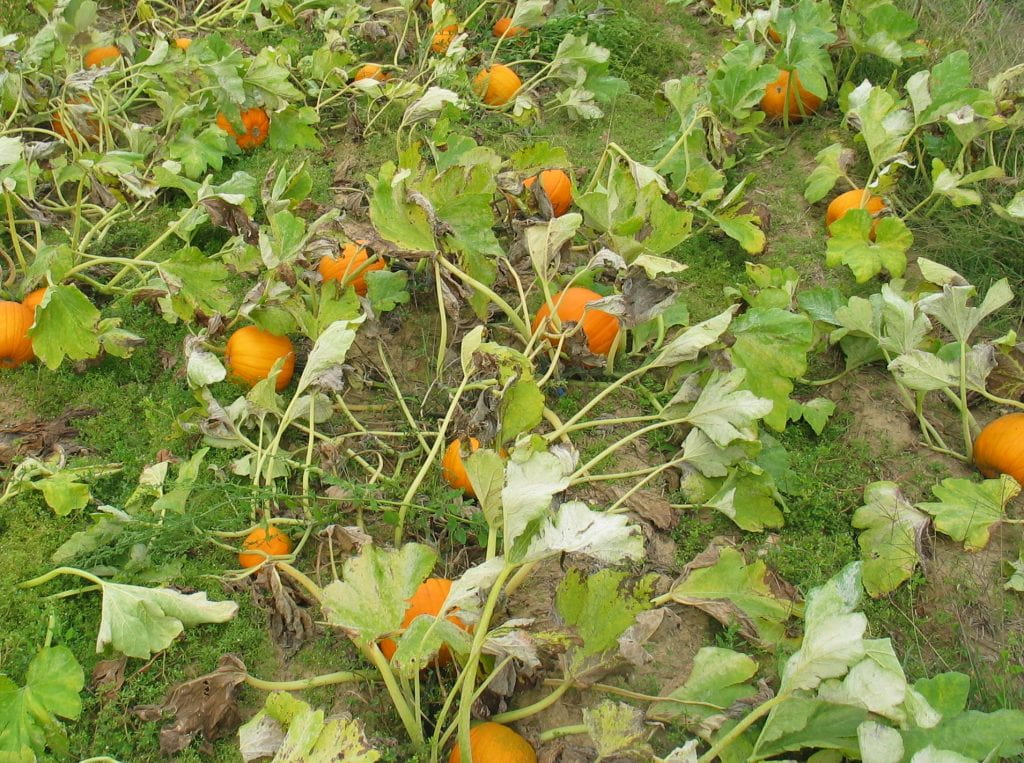
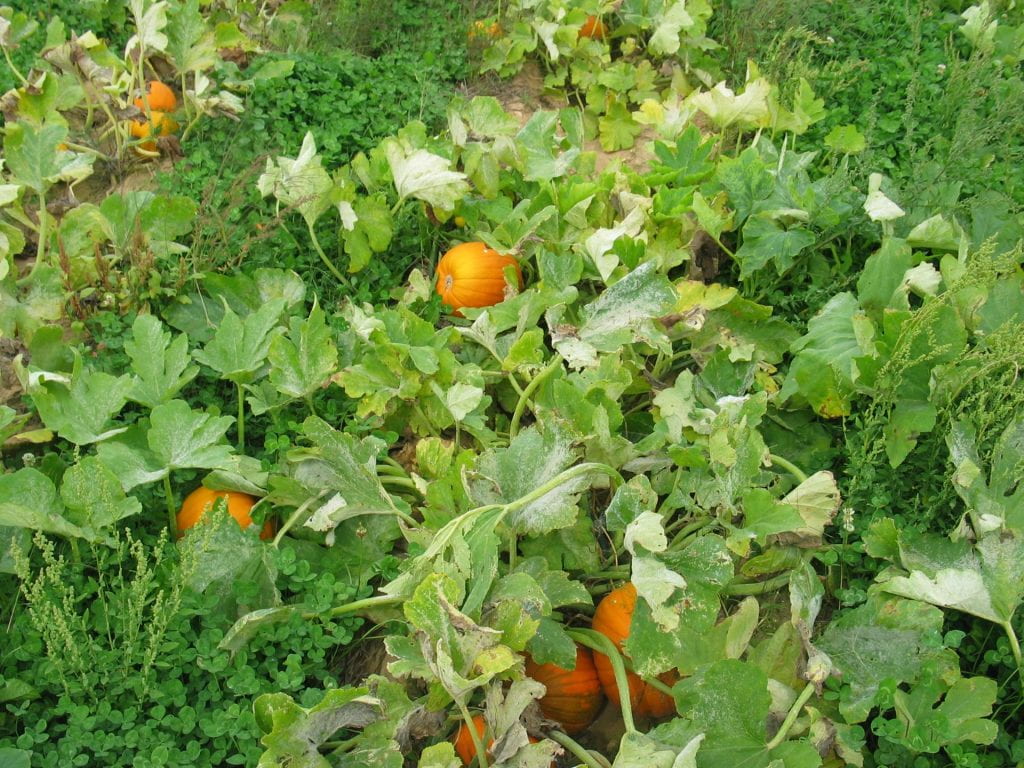
Reduced-Till Pumpkin Production in Rye Straw Mulch Plus Clover Living Mulch, 2004
Investigators: M. T. McGrath and D. D. Moyer
A long-term study was started in 2004 to address the impact of reduced tillage on soil health and diseases of vegetable crops. The 1.7-A field for this study is divided into 4 replicate sets of reduced tillage and conventional tillage strip plots extending the length of the field (20 ft X 300 ft) separated by driveways. The production system examined in 2004 was pumpkin zone-till seeded into rye straw mulch with a Dutch white clover living mulch planted between the pumpkin rows. This idea arose from discussions with an organic farmer who successfully grows pumpkins on plastic mulch with clover planted between the plastic. The system will be tested for continuous pumpkins by switching location of clover and pumpkin strips each year. Using a clover living mulch between rows of a crop provides an opportunity to put some land into a cover crop where rotation out of crops is not feasible due to the value of the land, as is the case for many Long Island fields. A living mulch also suppresses weeds. Soils with good health have higher organic matter content and higher microbial activity than poor quality soils, consequently there is greater potential for biological control of soil-borne pathogens. Straw and clover mulches provide a ground cover that can be a barrier for the pathogen. Thus this production system may be an effective management practice for pumpkin fruit rots, which are mostly caused by soil-borne pathogens and tend to be worst where rotation is minimal as is common for u-pick fields.
The field was planted to cover crops in 2003, then no-till seeded to rye on 2 Nov 2003. Fertilizer (176 lb/A of 34-0-0) was broadcast on 6 April 2004. Dutch white clover was no-till seeded to reduced-till plots and driveways on 11 May when rye was just starting to head out. Rye was rolled twice with a cultipacker in reduced-till plots on 2 June when rye was pollinating. Some rye stood back up immediately after rolling, but most stayed down. Rye was flail chopped in conventional till plots and driveways. Round-up was applied on 4 June in a 36-in band over the rows where pumpkins were to be planted in the reduced-till plots.
Two pieces of equipment were available for reduced tillage in 2004. Reduced tillage plots were divided in half and worked on 7 June. A zone-till cart built by Andy Williamson, vegetable farmer in Maine, was used in the north half. It was set-up to prepare single rows using 3 17-in wavy coulters to prepare a tilled strip with fertilizer tubes on the outer 2 coulters to inject liquid starter fertilizer. Amount of fertilizer (lb/A) applied to single rows is 12.5 N, 40 P, 25 K, 0.285 lb zinc, and 0.25 lb boron. An Unverferth zone builder was used in the south half of the reduced tillage plots after fertilizer (600 lb/A of 10-10-10) was broadcast over these subplots as well as the conventional-tillage plots. It was set-up to prepare 2 rows at 68-in spacing. For each row it has a 20-in coulter to open the row, shank to disrupt plow pans and create compression fissures between the shanks, and 2 17-in wavy coulters followed by a 15-in wide rolling basket to prepare the soil for planting. This unit was not equipped with a fertilizer tank. The Unverferth unit produced a wider bed that was deeper in the center where the shank went through than the zone-till cart (13-14 in. deep versus 4-5 in.).
In mid-June, rye that remained standing was flail chopped and conventional-tillage plots were rototilled. On 23 Jun pumpkin was seeded with 400 lb/A 10-10-10. There were 3 rows spaced 68-in apart in each plot. To achieve a similar concentration of N-P-K in all plots, the zone-till cart plots were side-dressed with 50 lb/A N as 10-10-10 on 27 Jul. On 25 Jun the herbicide Strategy was applied in a 34-in-wide band over all pumpkin rows and the insecticide Admire 2 was applied for cucumber beetles in a 7-in band. The field was irrigated lightly on 28 Jun, 2 Jul and 6 Jul. On 20 Jul the herbicides Sandea and Poast were applied, then the field was irrigated on 23 Jul.
Pumpkin plants did not grow well. Stand was very poor in the conventional-tillage plots perhaps because the soil was extremely dry and the light irrigation did not provide enough water to compensate for low rainfall (only 0.88 in. during Jun). Soil did not appear as dry in the reduced-till plots, which was expected due to both less tillage and presence of a mulch layer. For yield measurements, 15-ft-long sub-plots were established within plots where plant stand was best in the conventional-tillage plots. Conventional-tillage sub-plots averaged only 6.9 plants (range of 3 to 11), whereas there were 17.25 (16-18) plants in the Unverferth and 17 (14-19) in the zone-till cart reduced-tillage sub-plots. Plants were moved into the conventional-tillage sub-plots to obtain a stand similar to the reduced-tillage sub-plots. Pumpkin plants throughout the field became yellow by 6 Aug indicating insufficient N or possibly injury from Sandea; however, yellowing did not disappear as expected with Sandea injury. Plants remained small compared to plants of this variety in other experiments.
Weeds were not managed adequately possibly due to irrigation not being done promptly (within 24 – 48 hr) and weeds being too well established at the time of application. Clover grew well, eventually covering most plot area except about a 7-in wide strip where the pumpkins were seeded. Rye straw partly covered the soil surface through the season.
Pumpkins in sub-plots were harvested and weighed on 17 and 20 Sep. Numerically more fruit were harvested from the reduced-tillage sub-plots (average of 16.75 fruit from both compared to 14 and 14,5 from adjacent conventional tillage sub-plots) and the average fruit weight was greater (8.9 lb for Unverferth sub-plots, 10.1 lb for zone-till cart sub-plots, and 7.8 and 8.4 lb for adjacent conventional tillage sub-plots, respectively); however, these differences were not statistically significant.
Penetrometer measurements were made on 23-24 Sep outside of the sub-plot areas in each plot. Soil depth at which the penetrometer reading reached 300 psi in the planted row averaged 7.5 in. for the zone-till cart sub-plots, 6.7 in. for adjacent conventional-till plots, 14.4 in. for the Unverferth sub-plots, and 4.6 in. for adjacent conventional-till plots, while in other pumpkin experiments it was 10.6 in. where the entire field was conventionally tilled with a disk and 7.6 in. where plastic mulch was used.
Friends of Long Island Horticulture Grant Program funded this project and provided half of the funds for purchasing the no-till seeder.
More information/prepared by:
Margaret Tuttle McGrath
Associate Professor
Long Island Horticultural Research and Extension Center (LIHREC)
Plant Pathology and Plant-Microbe Biology Section
School of Integrative Plant Science
College of Agriculture and Life Sciences
Cornell University
mtm3@cornell.edu


